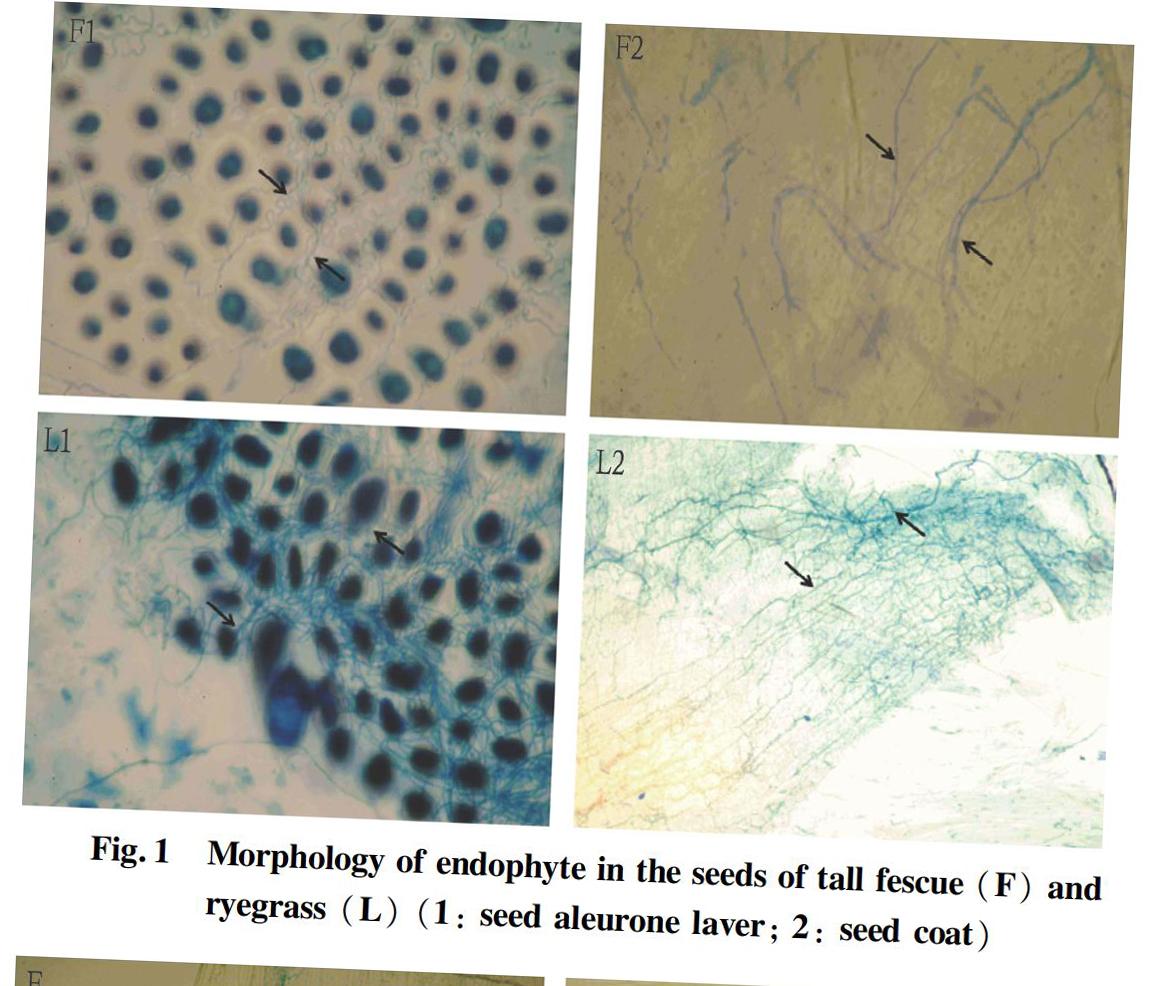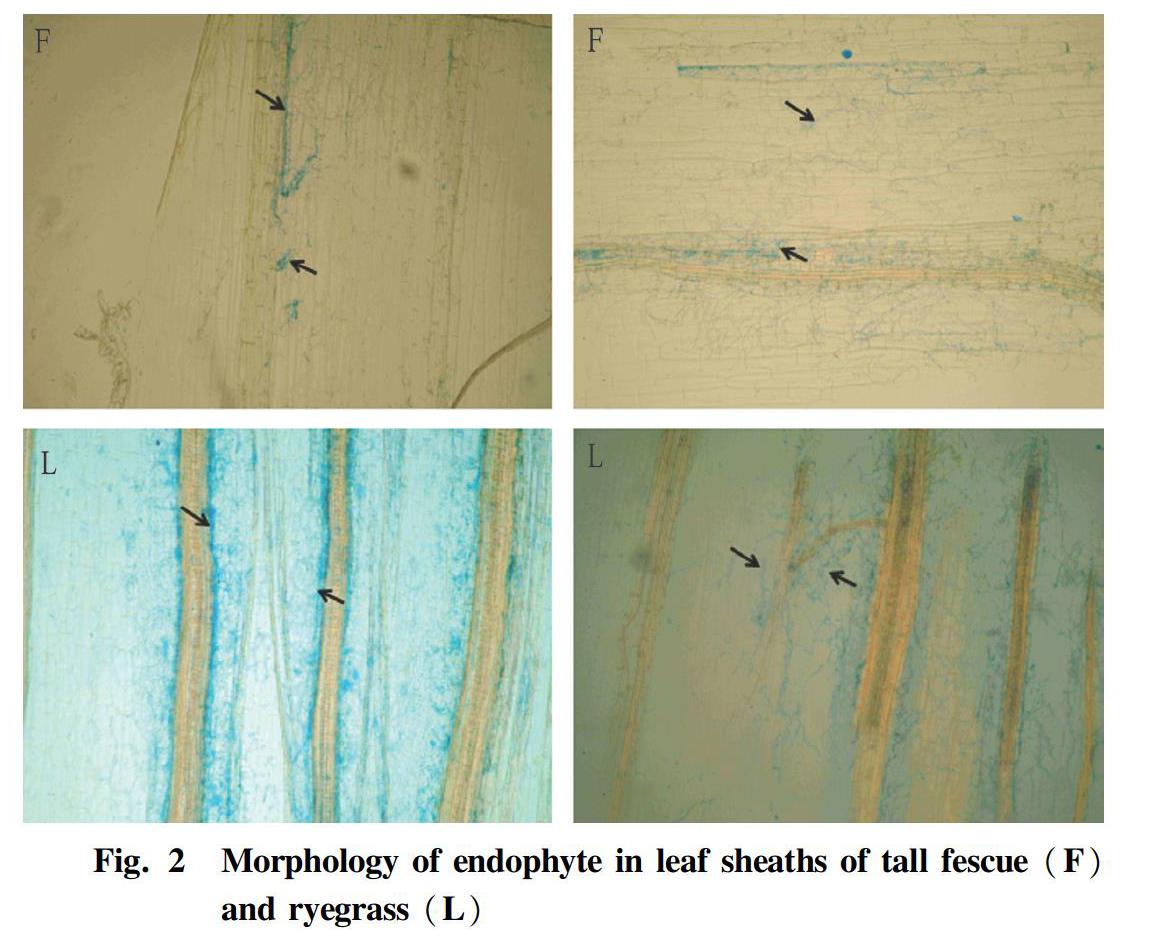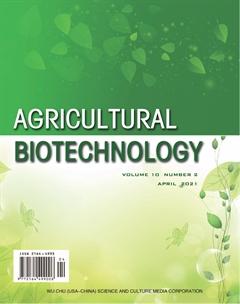Study on Sterilization Method of Endophytic Fungi in Tall Fescue (Festuca arundinacea) and Ryegrass (Lolium perenne) Seeds
Chaojie YANG Ying HONG Jianyue MAO Shulan ZHAO Lian DUO



Abstract [Objectives] This study was conducted to obtain the best solution for sterilizing tall fescue (Festuca arundinacea) and ryegrass (Lolium perenne) seeds by heating in a water bath for a short time.
[Methods]The tall fescue and ryegrass seeds infected with endophytic fungi were sterilized by heating in a water bath to compare seed germination and initial growth of turfgrass seedlings under different treatment time.
[Results] Sterilization in a 60 ℃ water bath for 20 and 30 min both inhibited the germination of tall fescue and ryegrass seeds, while the 20 min treatment did not significantly affect the lengths of stems, leaves and roots of seedlings. The 20 min water bath sterilization treatment had no effects on the plant heights and biomass of the two turfgrass seedlings and the tiller number of ryegrass, but sterilization for 30 min significantly reduced the aboveground and total biomass of seedlings and the tiller number of ryegrass.
[Conclusions]Sterilization in a water bath at 60 ℃ for 20 min achieved rapid sterilization in a short time, without significantly negatively affecting the growth of seedlings.
Key words Festuca arundinacea; Lolium perenne; Endophytic fungus; Sterilization method
Received: November 5, 2020 Accepted: January 3, 2020
Supported by the National Natural Science Foundation of China (31870484).
Chaojie YANG (1996-), female, P. R. China, master, devoted to research about pollution ecology.
*Corresponding author. E-mail: duolian_tjnu@163.com.
Endophytic fungi refer to a large class of fungi that spend all or most of the life cycle in seeds or plants of grass while the grass does not show adverse symptoms[1]. The entire life cycle of this class of fungi is spent in the host plants without producing fruiting bodies and spores. The hyphae invade the embryos during the early development of the hosts, and exist in the cotyledons and coleoptiles in the form of mycelia[2].
Endophytic fungi are widespread in terrestrial ecosystems with relatively abundant diversity. Under natural conditions, grasses are commonly infected with endophytic fungi[3]. To obtain experimental grasses uninfected by endophytic fungi, it is necessary to kill endophytic fungi through physical or chemical methods. At present, the methods for killing endophytic fungi include microwave method, fungicide method, long-term storage at room temperature, dry heat method, moist heat method and hot water bath. Microwave sterilization cannot achieve a complete sterilization effect[4]. Fungicides have certain adverse effects on the plants[5]. The dry heat and long-term storage treatments cannot achieve rapid sterilization[6-8]. The moist heat sterilization requires equipment and processing time[9]. The water bath method consumes a short heating time and has a good sterilization effect, but it will have an adverse effect on the seed germination[10].
In this study, with tall fescue (Festuca arundinacea) and ryegrass (Lolium perenne) seeds infected with endophytic fungi as experimental materials, a short-time water bath heating method was adopted to obtain plants without endophytic fungi. By comparing the seed germination and initial growth of turfgrass seedlings under different treatment times, the best solution for obtaining sterilized tall fescue and ryegrass seeds by heating in a water bath for a short time was obtained.
Materials and Methods
Experimental materials
The soil was sampled from the surface soil of 0-20 cm in the campus of Tianjin Normal University. The basic properties were pH 7.45, organic matter content 4.68%, alkali-hydrolyzable nitrogen 137.42 mg/kg, available potassium 71.63 mg/kg, and available phosphorus 22.03 mg/kg.
The varieties of tall fescue and ryegrass seeds were Kentucky-31 and Accent, respectively. They were purchased from Suqian Huiyi Seed Industry Co., Ltd.
Experimental methods
Sterilization treatments
Tall fescue and ryegrass seeds with full grains and uniform size were selected and soaked in cold water at 5 ℃ for 2 h, and then treated in hot water bath at 60 ℃ for 20 and 30 min, respectively, for seed germination and seedling growth experiments. The control group was prepared with seeds stored in a refrigerator at 4 ℃.
Endophytic fungus assay
Seed fungus detection: The seeds were soaked in 5% NaOH solution for 8 h, washed with tap water to remove most of the alkali, and boiled in aniline blue dye solution A (aniline blue 0.325 g, distilled water 100 ml, 85% lactic acid 50 ml) for 3-5 min. Then, 100 seeds were taken randomly, and the seed coat was separated from the aleurone layer. They were placed on a glass slide containing aniline blue dye solution B (phenol 10 g, lactic acid 10 g, glycerin 20 g, aniline blue 0.025 g, and distilled water 10 ml), stained for 10-20 min, and covered with a cover glass. After sucking off the excess staining solution, the seeds were observed under an optical microscope.
Plant sheath fungus detection: After the treated seeds germinated on moist filter paper, 200 germinated seedlings were transferred to plastic pots filled with soil, and detected for endophytic fungi after 6 weeks. Mature leaf sheaths were cut, and boiled for 5 min, and the upper epidermis inside the leaf sheath was tore off, and placed on a glass slide with a drop of aniline blue dye B thereon with the torn side downwards. After 10-20 min of staining, the slide was covered with a cover glass and observed under an optical microscope.
Seed germination experiment
A hundred treated seeds were placed on moist filter paper in a petri dish to germinate, and each treatment was repeated 4 times. The germination experiment was carried out in a 25 ℃ incubator, with seeds stored in a refrigerator at 4 ℃ as a control. The germination conditions of the seeds were observed every day with the length of the radicle equal to half the length of the seed as the standard of seed germination. The number of germinated seeds was recorded from the 4th d after sowing; the germination potential was calculated on the 8th d; and the germination rate was counted on the 10th d, and the germination index was calculated. In the last measurement of germination rate, 5 seedlings were randomly selected to measure the length of their roots, stems and leaves.
Seedling growth experiment
Fifty seedlings were selected and transferred to plastic pots (7 cm in diameter and 8 cm in height) containing 400 g of soil. During the cultivation period, water was supplied to keep at 60% of the maximum water holding capacity. The plants were then cultured at a room temperature of 20-27 ℃ and relative humidity of 17%-54%, and irradiated with natural light. The plant height and biomass of seedlings were measured at 30 d, and the tiller number was counted.
Data processing
The SPSS 20.0 software was used for one-way analysis of variance. The Tukeys test was used to analyze the significant differences between treatments at the P=0.05 level. Plotting was performed in Origin 9.1.
Results and Analysis
Endophytic fungus detection
As shown in Fig. 1, the endophytic fungi in tall fescue and ryegrass seeds were mainly distributed in the aleurone intercellular space and seed coat. The infection rate of tall fescue seeds under microscope was 100%, and that of ryegrass seeds was more than 80%.
The morphology of endophytic fungi in tall fescue and ryegrass leaf sheaths is shown in Fig. 2. In the control group, the detection rates of tall fescue and ryegrass sheath were 99% and 82%, respectively. Sporadic endophytic fungi were observed in the leaf sheaths of tall fescue and ryegrass treated at 60 ℃ for 20 and 30 min, and the detection rate was less than 5%. Both heating time could inactivate endophytic fungi.
Seed germination
As shown in Table 1, the germination rate, germination potential and germination index of the two turfgrasses treated by sterilization were significantly lower than those of the control (P<0.05), and decreased with the increase of treatment time. The lengths of stems, leaves and roots of the seedlings were not significantly different from the control in the 20 min treatment (P>0.05), while significant differences were found between the control and the 30 min treatment (P<0.05).
Seedling growth
The effects of different sterilization treatment time on the tiller number, plant height and biomass of seedlings are shown in Table 2. The plant heights and biomass of the two species of turfgrass seedlings sterilized for 20 min were not significantly different from those of the control groups (P>0.05). The shoot weight and totalweight of seedlings treated for 30 min were significantly lower than those of the control groups (P<0.05). The tall fescue seedlings had no tillers, which might be related to the seed variety and sowing density. The treatment for 20 min had no significant effect on the tiller number of ryegrass, while the treatment for 30 min significantly decreased the tiller number of ryegrass compared with the control (P<0.05).
Chaojie YANG et al. Study on Sterilization Method of Endophytic Fungi in Tall Fescue (Festuca arundinacea) and Ryegrass (Lolium perenne) Seeds
Conclusions and Discussion
The endophytic fungi of tall fescue and perennial ryegrass can survive in the grass for a long time. The survival time in seeds depends on the seed storage time, storage temperature and humidity. Generally, they can survive for 1 to 2 years. Plants without endophytic fungi can be obtained by killing endophytic fungi in the seeds.
Zhang et al.[4] found that microwave treatment can significantly kill endophytic fungi in seeds, but it could not remove completely. Huang and Huang [5] used three fungicides to sterilize Brachiaria brizantha Stapf plants and found that each fungicide had a sterilizing effect, but none of them could remove 100% of the fungi. Harvey et al.[11] found that propiconazole had the best effect on killing endophytic fungi in ryegrass. Although fungicides can kill endophytic fungi in plants and seeds, insufficient dosage will have a poor sterilization effect, and excessive amounts will reduce seed vigor and forage growth. Therefore, microwave sterilization and chemical sterilization methods are not the best methods for removing endophytic fungi.
The high-temperature dry heat method can also kill endophytic fungi in grass seeds. Li et al.[6] used Achnatherum sibiricum (L.) Keng to study the effects of high temperature dry heat treatment on endophytic fungi and seed vigor and found that the 60 ℃ treatment within 30 d completely eliminated the endophytic fungi in A. sibiricum seeds, and the seed germination rate and the growth of seedlings had not been negatively affected. Welty et al.[12] used the 60 ℃ dry heat method to treat tall fescue and ryegrass seeds infected with endophytic fungi and found that the endophytic fungi activity in the seeds decreased significantly, but it took at least 20 weeks to kill all the endophytic fungi in tall fescue seeds, and the ryegrass seeds needed a longer time. Moreover, the germination rates of tall fescue and ryegrass seeds decreased significantly. The dry heat sterilization takes a long time, and the seed germination rate will be significantly reduced, so it cannot meet the needs of rapid sterilization.
Welty and Azevedo[13] reported that moisture heat treatment could kill the endophytic fungi in tall fescue seeds. High temperature and high humidity methods are commonly used to kill bacteria and fungi in seeds[14]. Siegel et al.[15] completely killed endophytic fungi in tall fescue seeds with moist heat at 43 ℃ for 15 min and then with moist heat at 57 ℃ for 40 min, but the seed germination rate decreased from 91% to 83%. Although moist heat treatment can effectively kill endophytic fungi in grass seeds, the seed germination rate will be affected to varying degrees.
At present, studies have reported that water bath heating can achieve good sterilization effects. In this study, both 20 and 30 min in 60 ℃ water bath could sterilize fungi, but both decreased seed germination with the extension of time. For the seeds treated for 20 min, the stem and leaf lengths and root length of the seedlings were not significantly different from those of the control. Li et al.[6] showed that water bath treatment had an adverse effect on the stem and leaf growth of A. sibiricum seedlings in early stage, but the negative effect tended to disappear with the extension of the growth time. Ren[8] found that heat treatment of seeds in water bath had little effect on the leaf elongation of ryegrass seedlings, and had no effect on the growth and development of roots. In addition, compared with the control, treatments in a 60 ℃ water bath for 20 min had no significant effects on the growth parameters (tiller number, plant height, biomass) of the seedlings after the seeds germinated and were transplanted to the soil. Therefore, heating in a 60 ℃ water bath for 20 min could sterilize endophytic fungi rapidly in a short time, without adversely affecting the growth of seedlings.
References
[1] SIEGEL MR, LATCH GCM, BUSH LP, et al. Fungal endophyte-infected grasses: Alkaloid accumulation and aphid response[J]. Journal of Chemical Ecology, 1990, 16(12): 3301-3315.
[2] SIEGEL MR, LATCH GCM, JOHNSON MC. Acremonium fungal endophyes of tall fescue and perennial ryegrass: significance and control[J]. Plant Disease, 1985, 69(2): 179-183.
[3] RASHMI M, KUSHVEER JS, SARMA VV. A worldwide list of endophytic fungi with notes on ecology and diversity[J]. Mycosphere, 2019(10): 798-1079.
[4] ZHANG RS, AN SZ, SHI C, et al. Germicidal efficacy of microwave on endophyte and its effects on the germinating vigor of Elymus dahuricus[J]. Chinese Journal of Grassland, 2016, 38(1): 100-104. (in Chinese)
[5] HUANG DY, HUANG XL. Study on the elimination of endophytic fungi in Brachiaria spp. by fungicide[J]. Journal of Anhui Agricultural Sciences, 2008, 36(30): 13097-13152. (in Chinese)
[6] LI X, HAN R, REN AZ, et al. Using high-temperature treatment to construct endophyte-free Achnatherum sibiricum[J]. Microbiology China, 2010, 37(9): 1395-1400. (in Chinese)
[7] SHI C, LU Y, HUANG CF, et al. Using 70℃ dry treatment to make endophyte-free seeds of Melica transsilvanica[J]. Acta Agrestia Sinica, 2016, 24(6): 1318-1322. (in Chinese)
[8] REN AZ. Physiological-ecological mechanisms of endophyte effect on drought adaption of Lolium perenne L.[D]. Tianjin: Nankai University, 2003. (in Chinese)
[9] SIEGEL MR, VARNEY DR, JOHNSON MC, et al. A fungal endophyte of tall fescue: Evaluation of control methods[J]. Phytopathology, 1984, 74(8): 937-341.
[10] WILLIAMS MJ, BACKMAN PA, CLARK EM, et al. Seed treatments for control of the tall fescue endophyte Acremonium coenophialum[J]. Plant Disease, 1984, 68(1): 49-52.
[11] HARVEY IC, FLETCHER LR, EMMS LM. Effects of several fungicides on the Lolium endophyte in ryegrass plants, seeds, and in culture[J]. New Zealand Journal of Agricultural Research, 1982, 25(4): 601-606.
[12] WELTY RE, AZEVEDO MD, COOPER TM. Influence of moisture content, temperature, and length of storage on seed germination and survival of endophytic fungi in seeds of tall fescue and perennial ryegrass[J]. Phytopathology, 1987, 77(6): 893-900.
[13] WELTY RE, AZEVEDO MD. Survival of endophyte hyphae in seeds of tall fescue stored one year[J]. Phytopathology, 1985(75): 1331.
[14] GRONDEAU C, SAMSON R, SANDS DC. A review of thermotherapy to free plant materials from pathogens, especially seeds from bacteria[J]. Critical Reviews in Plant Sciences, 1994, 13(1): 57-75.
[15] SIEGEL MR, VARNEY DR, JOHNSON MC, et al. A fungal endophyte of tall fescue: Evaluation of control methods[J]. Phytopathology, 1984, 74(8): 937-341.
- 农业生物技术(英文版)的其它文章
- A Preliminary Screening of Optimum Medium and Symbiotic Fungi for Paphiopedilum dianthum
- Genetic Diversity and Genetic Structure of Maize Inbred Lines from Yunnan Revealed by SNP Chips
- Molecular Marker Techniques Using Single Primers and Their Advances
- The Comparison of Cold tolerance of Three Species of Evergreen Broad-leaved Woody Plants
- Technical Regulations for Standardized Planting of Rare and Multi-purpose Wild Fruit Kadsura coccinea
- Occurrence and Control of Weeds in Abandoned Fields in Central Hunan

